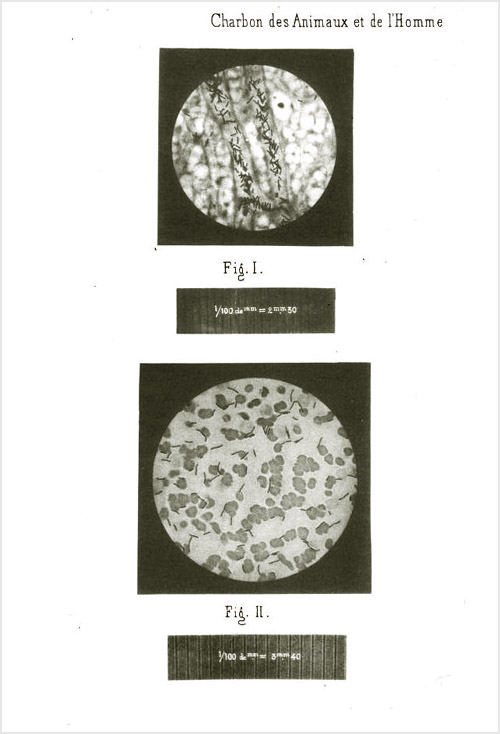
Paris : Aux Bureaux du Progrès médical ; A. Delahaye et E. Lecrosnier, 1887.
Description : iv, 1-223 p., [2] p., [1 l.] pl. ; ill.: phots., 4 in-text engrs. ; 22.5 cm.
Photographs : phototypes—2 photomicrographs with legends on 1 leaf.
Photographer : Dr. Pierre-Paul-Émile Roux (1853-1933).
Subject : Vascular system — Anthrax.
Notes :
Fig.II, — Sang d'un Cobaye mort du charbon. Les bacilles étaient colorés au bleu de méthylène, les globules du sang par l'éosine. Obj. 16,6 de Vérick. Le grossissement mesuré sur la photographie du micromètre est de 340 diamètres.
Fig. I . — Mésentère d'un cobaye mort du charbon, les bacilles étaient colorés au violet de gentiane, le tissu à l'éosine. Obj. apochromatique 3,0 — 1,30 de Zeiss. Le grossissement mesuré sur la photographie du micromètre est de 230 diamètres.

Includes a chapter on materno-fetal transmission, an area of expertise for Straus. His first research into congenital infections, including the anthracic fetus, was conducted at Pasteur's laboratory in collaboration with Pasteur's assistant, Charles Chamberland (1851-1908). They published three papers, the first two in Comptes rendus de la Société de Biologie (1882, 7. s., iv, 683-688 ; 804-810) and the third in Archives de physiologie normale et pathologique (1883, 3. s., i, 436-475). Chamberland and Roux—who provided the photomicrographs for this book—were both indispensible to Pasteur, responsible for developing the anthrax vaccine that powered a remarkable demonstration on May 5, 1881 in Pouilly-le-Fort. The success of the vaccination experiment was irrefutable and won popular support for Pasteur and his work. Roux also provided the method whereby Pasteur could demonstrate innoculation of rabies in canines. In 1883, Pasteur appointed Straus to lead a team of bacteriologists to study the cholera epidemic in Egypt, but that project was fatigued by the loss of a team member to the disease and by the scientific successes of Koch and his team.
